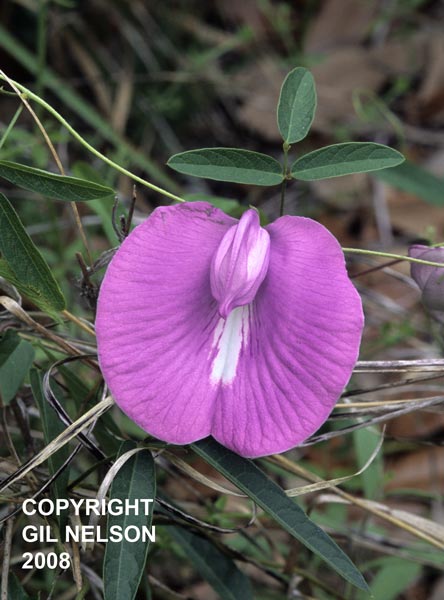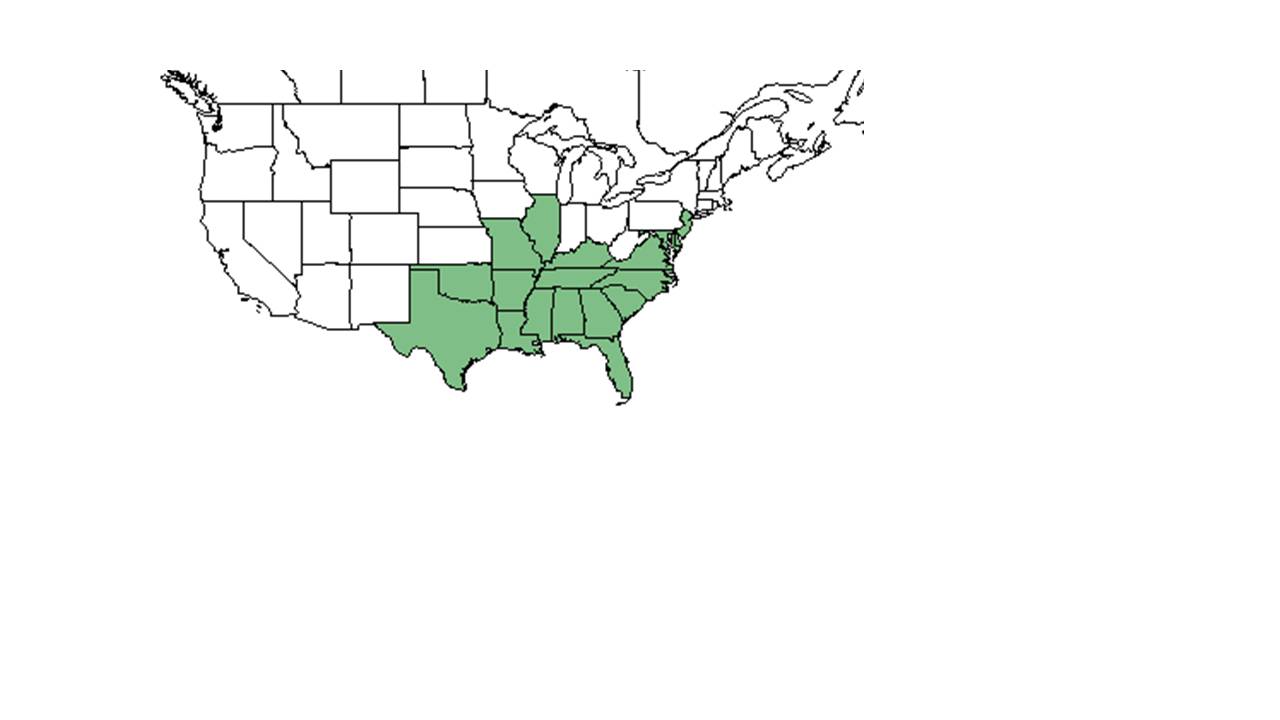Difference between revisions of "Centrosema virginianum"
(→Description) |
|||
| Line 19: | Line 19: | ||
==Description== | ==Description== | ||
<!-- Basic life history facts such as annual/perrenial, monoecious/dioecious, root morphology, seed type, etc. --> | <!-- Basic life history facts such as annual/perrenial, monoecious/dioecious, root morphology, seed type, etc. --> | ||
| − | Common | + | Common name: Spurred Butterfly Pea |
==Distribution== | ==Distribution== | ||
Revision as of 14:20, 6 July 2015
| Centrosema virginianum | |
|---|---|

| |
| Photo by Gil Nelson | |
| Scientific classification | |
| Kingdom: | Plantae |
| Division: | Magnoliophyta - Flowering plants |
| Class: | Magnoliopsida – Dicotyledons |
| Order: | Fabales |
| Family: | Fabaceae ⁄ Leguminosae |
| Genus: | Centrosema |
| Species: | C. virginianum |
| Binomial name | |
| Centrosema virginianum (L.) Benth. | |

| |
| Natural range of Centrosema virginianum from USDA NRCS Plants Database. | |
Contents
Description
Common name: Spurred Butterfly Pea
Distribution
Ecology
It is a legume that has one of the highest nitrogen-fixing potentials (Cathey et al 2010). Because of this, it may be able to help restore N lost from fire (Hainds et al 1999). By mid-season in June and July, a maximum nitrogen-fixing rate was observed (Cathey et al 2010).
Habitat
It is found in a wide range of natural and disturbed conditions, including frequently burned sandhills, upland longleaf-wiregrass and old-field pinelands (Cushwa 1966, Hainds 1999), and flatwoods, coastal island dunes and shorelines, open areas within mangrove swamps, wooded floodplains and edges of hardwood forests, and bogs . It can be found in loblolly pine communities (Cushwa 1966). It can also be found in longleaf pine-wiregrass communities (Hainds et al 1999). It is tolerant of overstory canopies that decrease the light level to about half the ambient (i.e., it can live in partially shaded areas and its nitrogen-fixing capability won't be significantly affected) (Cathey et al 2010). It grows in highly disturbed areas, but it is also ubiquitous in high quality native longleaf pine uplands and sandhills. It occurs in soils ranging from deep sands (Entisols) to sandy loams (Ultisols).
Phenology
It flowers in April through October and fruits primarily in June thorugh September (FSU Herbarium).
Seed dispersal
Seed bank and germination
In Hier's study, changes in flowering did not seem to affect seed germination (Hiers et al 2000). It spreads clonally by production of rhizomes (Hiers et al 2007).
Fire ecology
It thrives under fire (Cushwa 1966). Hendricks observed that the Piedmont National Wildlife Refuge plots, which had been under a 4-year burning regime since 1966, each contained more than 10 times more C. virginianum individuals per ha than the Oconee National Forest plots, which had no burning history (Hendricks et al 1999). Seasonal burning does not seem to negatively affect nitrogen fixation (Hiers et al 2003). C. virginianum showed increased flowering synchrony in response to lightning-season burns (Hiers et al 2000). It responded the best to March burns with respect to annual tissue inputs as well as nitrogen contribution (Hiers et al 2003). C. virginianum showed robust flowering response to late winter/ early spring burns, supporting the response to March burns noted earlier. It has a mid-summer flowering peak (Hiers et al 2000). Also, Hiers found no evidence that increased flowering affects nitrogen-fixing capability (Hiers et al 2003).
Pollination
Its flower is highly specialized for pollination by large Hymenoptera (Spears 1987 cited by Hiers et al 2007). It requires bees for pollination to "trip" the pollen delivery mechanism. Pollinator-plant relationships appear to be robust to alteration in flowering phenology resulting from variation in season of burn (Hiers et al 2000).
Use by animals
Because C. virginianum is a legume, and legumes are high in protein and mineral content, a number of herbivores including but not limited to Gopherus polyphemus, white-tailed deer, and bob-white quail, consume it (Hainds et al 1999).
Diseases and parasites
Conservation and Management
Cultivation and restoration
Photo Gallery
References and notes
Cathey, S. E., L. R. Boring, et al. (2010). "Assessment of N2 fixation capability of native legumes from the longleaf pine-wiregrass ecosystem." Environmental and Experimental Botany 67: 444-450.
Cushwa, C. T. (1966). The response of herbaceous vegetation to prescribed burning. Asheville, USDA Forest Service.
FSU herbarium herbarium.bio.fsu.edu
Hainds, M. J., R. J. Mitchell, et al. (1999). "Distribution of native legumes (Leguminoseae) in frequently burned longleaf pine (Pinaceae)-wiregrass (Poaceae) ecosystems." American Journal of Botany 86: 1606-1614.
Hendricks, J. J. and L. R. Boring (1999). "N2-fixation by native herbaceous legumes in burned pine ecosystems of the southeastern United States." Forest Ecology and Management 113: 167-177.
Hiers, J. K., R. Wyatt, et al. (2000). "The effects of fire regime on legume reproduction in longleaf pine savannas: is a season selective?" Oecologia 125: 521-530.
Hiers, J. K., R. J. Mitchell, et al. (2003). "Legumes native to longleaf pine savannas exhibit capacity for high N2-fixation rates and negligible impacts due to timing of fire." New Phytologist 157: 327-338.
Hiers, J. K. and R. J. Mitchell (2007). "The influence of burning and light availability on N-2-fixation of native legumes in longleaf pine woodlands." Journal of the Torrey Botanical Society 134: 398-409.
Spears, Jr. E. E. 1987. Island and mainland pollination ecology of Centrosema virginianum and Opuntia s trie ta. J. Ecol. 75: 351-362.